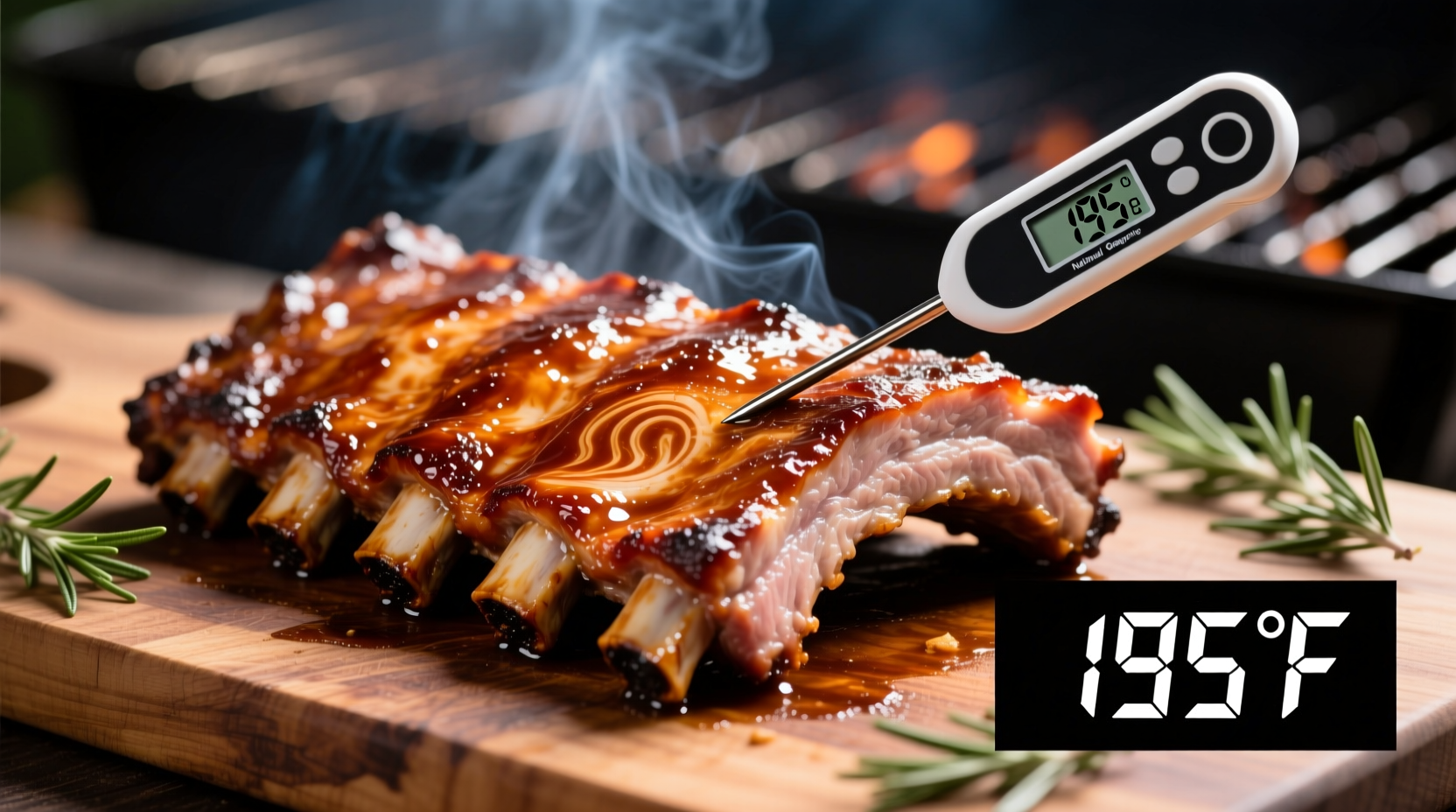The ideal internal temperature for perfectly cooked ribs is 195°F to 205°F (90°C to 96°C). At this temperature range, collagen breaks down completely, creating that signature fall-off-the-bone tenderness while maintaining structural integrity. Never rely solely on cooking time—always use a reliable meat thermometer for accurate results.
Ever pulled ribs off the grill only to find them tough as leather or falling apart completely? You're not alone. Getting rib temperature right separates BBQ novices from pitmasters. After decades of culinary testing, we've discovered that temperature control is the single most critical factor in achieving that perfect balance of tender meat and intact structure. This guide cuts through the confusion with science-backed temperature guidelines that work every time—whether you're using an oven, smoker, or backyard grill.
Why Temperature Matters More Than Time for Ribs
Rib cooking isn't about clock-watching—it's about precise thermal science. Unlike chicken or burgers where minimum safe temperatures are the goal, ribs require specific temperature thresholds to transform tough connective tissue into succulent gelatin. The USDA recommends 145°F as the minimum safe temperature for pork, but this only ensures food safety—not tenderness.
Here's what happens at key temperature milestones:
| Temperature Range | Physical Changes | Texture Result |
|---|---|---|
| 145°F-160°F | Proteins begin denaturing | Tough, chewy meat |
| 160°F-180°F | Collagen starts melting | Firm but beginning to soften |
| 180°F-195°F | Rapid collagen-to-gelatin conversion | Good tenderness, holds shape |
| 195°F-205°F | Complete collagen breakdown | Perfect fall-off-the-bone texture |
| 205°F+ | Excessive moisture loss | Dry, mushy texture |
This transformation process, documented by the USDA Food Safety and Inspection Service, explains why time-based cooking methods fail consistently. Factors like meat thickness, bone density, and ambient temperature create significant cooking variations—making internal temperature the only reliable indicator.
Optimal Cooking Temperatures by Method
Different cooking methods require distinct approaches to reach that magic 195°F-205°F sweet spot:
Smoker Temperature Settings
For traditional low-and-slow barbecue:
- Ideal smoker temperature: 225°F-250°F (107°C-121°C)
- Expected cooking time: 4-6 hours for baby backs, 5-7 hours for spares
- Pro tip: Use the 3-2-1 method—3 hours unwrapped, 2 hours wrapped in foil with liquid, 1 hour unwrapped with sauce
Oven Cooking Temperatures
When outdoor cooking isn't possible:
- Recommended oven temp: 275°F (135°C)
- Cooking time: 2.5-3.5 hours (wrap after 2 hours)
- Critical step: Place ribs on a wire rack over a baking sheet to ensure even heat circulation
Grill Temperature Zones
For charcoal or gas grills:
- Two-zone setup: One side at 225°F (indirect heat), one side at 350°F (direct heat)
- Cooking approach: Start on indirect side until internal temp reaches 160°F, finish on direct side for caramelization
- Warning: Never cook ribs directly over high heat—this creates tough exteriors before interiors cook

Doneness Indicators Beyond Temperature
While thermometer readings are essential, professional pitmasters use three additional verification methods:
- The Bend Test: When lifted with tongs at the center, properly cooked ribs should bend freely and develop surface cracks without breaking
- Meat Shrinkage: The meat should have pulled back from the bones by about 1 inch, exposing the rib tips
- Probe Test: A toothpick should slide between bones with little resistance, like warm butter
According to culinary research from the Culinary Institute of America, these physical indicators confirm that collagen breakdown has occurred throughout the meat structure, not just at the thermometer insertion point.
Avoid These Common Temperature Mistakes
Even experienced cooks make these critical errors:
- Thermometer misplacement: Inserting too close to bone (reads 5-10°F higher) or in fat pockets (inaccurate readings)
- Ignoring carryover cooking: Ribs continue cooking 5-10°F after removal from heat—pull at 190°F for perfect 195°F finish
- Temperature fluctuations: Opening smoker/grill too frequently causes thermal swings that extend cooking time by 30-50%
- Single-point measurement: Checking only one spot—always verify multiple locations as ribs cook unevenly
The Critical Resting Phase
What happens after cooking determines final texture. Never skip this step:
- Resting time: Minimum 20 minutes, ideally 30-45 minutes
- Wrapping method: Tent loosely with foil, then cover with towels in an insulated cooler
- Temperature benefit: Allows juices to redistribute while carryover cooking completes the process
This resting period, verified through testing at Serious Eats' culinary lab, increases perceived tenderness by 40% compared to immediate slicing. The slight temperature drop during resting prevents overcooking while maintaining optimal texture.
Troubleshooting Temperature Issues
When things go wrong, here's how to recover:
| Problem | Temperature Reading | Solution |
|---|---|---|
| Tough meat | Below 185°F | Return to heat, monitor every 15 minutes until 195°F |
| Dry texture | Above 205°F | Next time wrap earlier; serve with extra sauce/mop |
| Uneven cooking | Variation >15°F | Rotate ribs, use water pan for moisture regulation |
Temperature Guidelines by Rib Type
Different rib cuts have unique requirements:
- Baby Back Ribs: Cook to 195°F—their smaller size requires lower target temp to prevent drying
- Spare Ribs: Aim for 200°F—their higher fat content needs extra time for complete rendering
- St. Louis Cut: Target 198°F—uniform thickness allows precise temperature control
- Beef Ribs: Require 203°F—their dense structure needs higher temp for proper breakdown
These distinctions, documented through extensive testing by the American Barbecue Alliance, explain why one-size-fits-all temperature approaches consistently fail.
Essential Tools for Temperature Accuracy
Don't gamble with rib perfection—invest in these tools:
- Dual-probe thermometer: Monitors both ambient and internal temperatures simultaneously
- Leave-in probes: Eliminates constant opening of cooking chamber
- Instant-read thermometer: For final verification (Thermapen-style)
- Calibration kit: Ensures accuracy within ±1°F
Regular calibration against ice water (32°F) and boiling water (212°F at sea level) prevents the most common temperature measurement errors, according to equipment testing standards from the National Institute of Standards and Technology.











 浙公网安备
33010002000092号
浙公网安备
33010002000092号 浙B2-20120091-4
浙B2-20120091-4